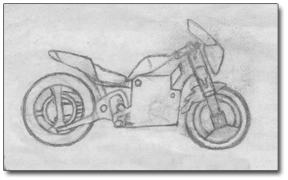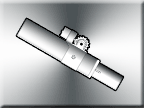Active electromechanical Suspension and Power Generation System Using An Acceleration Controller
|

|
This project started in 2011 in order to improve the efficiency of electric vehicles, which are often plagued by weight and battery life issues. (Honestly, I wanted to purchase an electric motorcycle, but I did not believe the price was worth the short range, power, and battery life.) While looking at electric motorcycles I noticed that kits were being sold on the internet, but after researching them I realized that they were just modified motorcycles. As an engineer, I knew that just swapping an engine with a motor is not an optimized design. So, I decided to design my own.
I began the design looking at every part of the vehicle from the wheels up. I believed that if I started with only an electric vehicle in mind I would be able to eliminate anything that would only apply to engines and by doing that I would improve the power to weight ratio. Then, I would be able to add things that would make the electrical aspects more efficient.
|
Anyway, the first thing I did was re-invent the wheel (see U.S. Patent 9,481,203), which cut the wheel weight in half and eliminated the need to add air, thus eliminating any problems associated with pneumatic tires. I was also able to eliminate the rear rotor and caliper, since I wanted all the breaking energy to be used to recharge the battery. However, the front frictional breaking system would have to remain. After the initial wheel prototypes were tested I started designing the suspension.
|

|

|
The original idea was to minimize the standard suspension, but the use of an active suspension was appealing; on the other hand, the ideal situation would be to combine the two. So, after going through several ideas I decided to replace the heavy hydraulic dampener with a lighter active electromechanical one. Of course one did not exist, so I just had to invent it myself. I then ran some test on some spare motors I had from a previous project, and from there figured out what I would need to get it to work. I created the first testable prototype in 2013, and modified it several times to try to fix any problems that arose. In 2015 I still needed to test the suspension on a vehicle, but the previous prototype was not ready, so I built a small vehicle just for the suspension. The scaled-down vehicle used a pencil sharpener for the suspension's geared motor and it held the batteries and circuitry on it's back. It passed all it's tests with only minor adjustments. At that time I noticed that the voltage on the batteries had increased and after several more tests I realized that the motor was using regenerative breaking to charge the batteries. With this information I decided to record a test run and write up U.S. Patent 9,561,701.
|
After applying for the patent I tried contacting a few companies to see if they would like to license the technology. But I did not receive a response and I noticed that most of the people I talked to did not understand the application or implication of this technology--as it is the logical replacement for all vehicle suspensions. In 2016 I decided to continue prototypes with an intent to produce a consumer aftermarket product. In 2017, with growing interest in the prototypes, I decided to create this website as an advertisement and as a reference source. Thank you to all those who have shown an interest in this project/product.
--Jonathan J.
|
|


